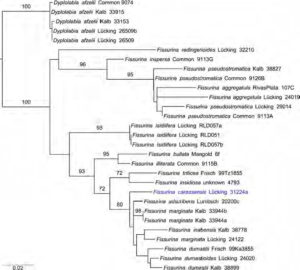Fissurina carassensis Lücking, Parnmen & Lumbsch, in Ariyawansa et al., Fungal Diversity: 10.1007/s13225-015-0346-5, [109] (2015)
Index Fungorum number: IF551487; Facesoffungi number: FoF00969
Etymology – Referring to the type locality.
Holotype – R. Lücking 31224a (SP).
Diagnosis – Differing from Fissurina dumastii in the apically smooth paraphyses and the more strongly I+ violet-blue ascospores, and from F. amazonica, F. coarctata and F. subcoarctata in the larger ascomata and I+ violet-blue ascospores.
Thallus corticolous on tree trunks, epiperidermal, up to 10 cm diam., continuous; surface smooth to uneven, mottled yellowish green to silvery grey, glossy; prothallus absent; thallus in section 70–130 μm thick, with prosoplectenchymatous cortex, 15–25 μm thick, photobiont layer 25–50 μm thick, and medulla, 30–50 μm thick, filled with numerous small, grey crystals that dissolve in K; large clusters of calcium oxalate crystals only present at the base of the ascomata. Photobiont Trentepohlia; cells rounded to irregular in outline, in irregular groups, yellowish green, 6–11×5–9 μm. Sexual morph: Ascomata lirellate, immersed-erumpent, irregularly branched and rather dense, with thin labia (fissurine), closed to very slightly gaping, 1–3 mm long, 0.15–0.25 mm broad, 0.1–0.13 mm high; disc more or less concealed; proper margin indistinct; thalline margin slightly ascending, entire, whitish to light yellowish grey. Excipulum orange -yellow, 20–30 μm wide, prosoplectenchymatous, fused with thalline margin; thalline margin 50–70 μm thick, anatomically similar to thallus; hypothecium prosoplectenchymatous, 10–15 μm high, hyaline; hymenium 70–80μm high, hyaline, clear; epithecium indistinct, 5–10 μm high, hyaline. Paraphyses unbranched, smooth; periphysoids present, rather distinct, shallowly and indistinctly warty; asci cylindrical, 70–80× 8–10 μm. Ascospores 8 per ascus, uniseriate, ellipsoid, 3- septate, 10–13×5–6 μm, 1.8–2.3 times as long as wide, hyaline, distoseptate with lens-shaped lumina, I+ violetblue. Asexual morph: Undetermined. Secondary chemistry: No substances detected by TLC; medulla P–, microscopic section K–.
Material examined – BRAZIL, Minas Gerais, Serra do Caraça, Reserva Particular do Patrimônio Natural (RPPN) Santuário do Caraça, trail through forest to chapel; 20° 06′ S, 43° 29′ W, 1300–1400 m, Atlantic Rain Forest, relatively well-preserved gallery forest (mata de galeria or floresta ombrófila densa montana) along small river, 27 July 2010, R. Lücking 31224a (SP holotype; F isotype).
Notes – Fissurina carassensis belongs in a complex of species centered around F. dumastii Fée, characterized by immersed- erumpent, fissurine ascomata, 3-septate, very small ascospores, and lack of secondary substances. Within this complex, the new species is characterized by its distinctly I+, violet-blue ascospores, whereas in F. dumastii the ascospores are only weakly I+ violet-blue and in the other species of this complex, F. amazonica M. Cáceres et al. (2014) and F. coarctata Makhija and Adawadkar (2007), they are I–. Fissurina dumastii also differs in its apically spinulose paraphyses (Staiger 2002), whereas F. amazonica and F. coarctata have very small lirellae (up to 1 mm long only). Molecular sequence data show that F. carassensis and F. dumastii are phylogenetically distinct (Rivas Plata et al. 2013; Fig. 1).

Fig. 1 Best-scoring maximum likelihood tree with bootstrap support values computed with RAxML 8.2 of selected species of Graphidaceae subfamily Fissurinoideae, including the new species Fissurina carassensis, using Dyplolabia afzelii as outgroup. For GenBank numbers based on voucher information
indicated in the tree, see (Rivas Plata et al. 2013)
